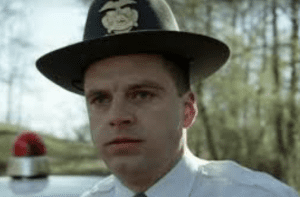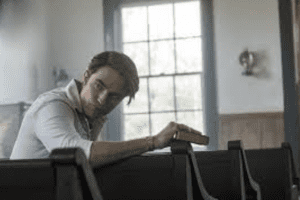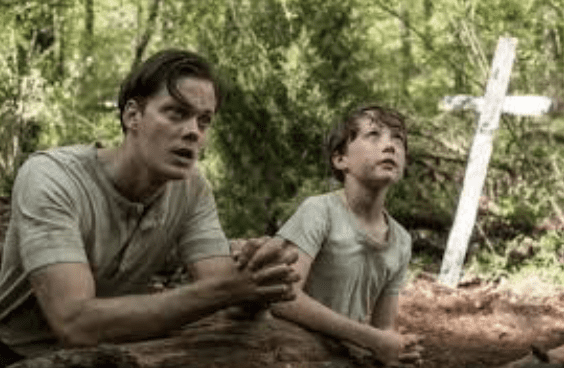That Old Time Religion
The Devil All the Time is streaming on Netflix
I’ve been to the South, but I’ve never been to The South. To clarify, years ago my wife and I took a week off for a road trip. We were on the East Coast then, and with the exception of a couple of trips to Florida, I had never spent any appreciable time further South than Maryland. I was intensely curious about what I would find.
Honestly, I loved it. In particular, I fell deeply in love with Charleston, the elegantly crumbling South Carolina city. The food? Incredible. The sights? Marvelous. The people? Delightful.* In particular was a couple we found ourselves chatting with over dinner one night. As you would expect, they were gregarious and warm, positively the avatars of Southern hospitality.
There was one moment, though. After time had passed and wine had been consumed, the husband leaned over to me and, with a smile, said, “So what do you think of The South? Do you think we’re all a bunch of rednecks?” I don’t think his question was loaded with hostility. I hope not. The look in his eye told me he hoped not to be looked down upon, especially not by the Yankees setting foot in his home.
 We all hold stereotypes, and I’m just as guilty. There’s a kind of literary stereotype about the South made popular by writers such as William Faulkner or Tennessee Williams. You might think of a small town awash in blood feuds, festering secrets, yearning romance, and a strain of Christianity that marches past faith into mania. I might not be able to physically visit that version of the South, but I can step into it occasionally with a film like The Devil All the Time, one positively dripping with Southern Gothic flavor.
We all hold stereotypes, and I’m just as guilty. There’s a kind of literary stereotype about the South made popular by writers such as William Faulkner or Tennessee Williams. You might think of a small town awash in blood feuds, festering secrets, yearning romance, and a strain of Christianity that marches past faith into mania. I might not be able to physically visit that version of the South, but I can step into it occasionally with a film like The Devil All the Time, one positively dripping with Southern Gothic flavor.
In 1945, Willard Russell (Bill Skarsgard) has gone to war. He’s a Marine deployed to the Solomon Islands, and the look on his face tells us of the horrors he’s seen already. Horror isn’t done with him, as he encounters a crucified gunnery sergeant who’s been left to a slow death. Willard puts the soldier out of his misery. The image of the cross, the bloodied man nailed to it, the flies buzzing around his face, it all creates a mosaic of misery that Willard will carry throughout his life.
In 1950, Willard has returned to America, met and married Charlotte (Haley Bennett), and bought a home in the small town of Knockemstiff.** Traveling preacher Roy Lafferty (Harry Melling) visits the church, and as a test of his faith, he dumps a jar of spiders on his head. Roy’s faith will be tested twice more when he murders and attempts to resurrect his wife Helen (Mia Wasikowska), and again when he meets traveling serial killers Carl (Jason Clarke) and Sandy (Riley Keough).
In 1957, Charlotte becomes sick. It’s cancer, and her time appears short. Willard has built a cross in the woods behind his home. He kneels and prays fervently, begging God, and if he can only pray hard enough, God is certain to save her. His young son, Arvin, prays alongside his father, and Arvin’s dog watches them curiously. Willard teaches Arvin. He teaches the boy about responding to violence with violence, and that sometimes sacrifices can seem bloody but necessary.
In 1965, Arvin (Tom Holland) is a young man who’s given the Luger pistol his father acquired during the war. His job, the only one that really matters, is to protect his half-sister Lenora (Eliza Scanlen). His job will become inhumanly difficult when new preacher Preston Teagardin (Robert Pattinson) arrives in town. Teagardin has an eye for young girls in general, and his eye roves onto Lenora. There’s a cycle of violence that Arvin is trapped in, and he might not be able to stop it.

If a movie is a meal, then The Devil All the Time is cinematic turducken. There is an awful lot of movie here, so much so that I wonder if it wouldn’t have worked a bit better as a miniseries. Director Antonio Campos does solid work juggling multiple timelines and a sprawling cast. He’s made a handsome film in which the camera prowls through small towns and lurks in the backseats of big cars. Yet there’s so much to unpack here that it frequently feels overwhelming, and I wished for more of a breather to reflect on what I’d seen.
Along similar lines, the screenplay by Antonio Campos and Paulo Campos absolutely bites off more than it can chew. We have violence cycling from a father to a son, corruption in law enforcement, perversion in the church, and a serial killer photographing the suffering of his victims as a way to get closer to the divine. I give props to filmmakers attempting something ambitious. This script is a little too ambitious as all the plot threads don’t always come together and don’t always successfully complement each other. When it works, it works well, closing the viewer into an emotional iron maiden.*** I respect Campos & Campos’ craftsmanship — I’m just happy I don’t have to watch this movie again.
Similarly, the cast is swinging for the fences here, and fans of good acting will find a lot to like. Looking for a Southern-fried scumbag? You’ll find him in Sebastian Stan’s utterly corrupt cop Bodecker. Perhaps you’d prefer a conflicted killer? Riley Keough plays Sandy with sadism and regret. I liked Bill Skarsgard’s Willard, a man buffeted with trauma who cries out to a God that might not reply. I really liked Tom Holland as Arvin. His range is impressive, and he makes the volcanic rage and sense of duty within the character feel real.
 We ought to take a moment to discuss the…ah…polarizing performance by Robert Pattinson as the vile Reverend Preston Teagardin. While everybody else in the cast sounds like they worked with a dialect coach and brought a regionally appropriate accent, Pattinson apparently came up with something on his own. Imagine Foghorn Leghorn given a quick blast of helium and a quick hit of crystal meth. Pattinson’s weird-ass delivery is added to a physical performance that’s occasionally twitchy and often reptilian. I’m unsure if a) his accent is either incredibly specific to the region or some kind of choice directly from his id or b) if he’s even delivering a good performance. All I know is, like the film he’s appearing in, he’s committing to taking big risks. I respect it, even if I have my doubts that a Southerner has ever walked the Earth speaking like that.
We ought to take a moment to discuss the…ah…polarizing performance by Robert Pattinson as the vile Reverend Preston Teagardin. While everybody else in the cast sounds like they worked with a dialect coach and brought a regionally appropriate accent, Pattinson apparently came up with something on his own. Imagine Foghorn Leghorn given a quick blast of helium and a quick hit of crystal meth. Pattinson’s weird-ass delivery is added to a physical performance that’s occasionally twitchy and often reptilian. I’m unsure if a) his accent is either incredibly specific to the region or some kind of choice directly from his id or b) if he’s even delivering a good performance. All I know is, like the film he’s appearing in, he’s committing to taking big risks. I respect it, even if I have my doubts that a Southerner has ever walked the Earth speaking like that.
The Devil All the Time feels like an overstuffed and effective distillation of trauma and faith set within a mythic South. At least, it feels that way to a Yankee like me. Once in a while, I think about the couple we met at that tiny restaurant in Charleston. I wonder how they are. I wish them well. I’m very curious about how they would respond to this film, if it would feel like a grotesque caricature to them, or if they would see a kind of truth that’s hidden from my eyes.
*We loved it so much that the only thing that kept us from relocating to Charleston was the brutal summer heat and 300 percent humidity. What can I say? I’m soft.
**I can just imagine the first town planning meeting, and a nervous voice says, “Um…guys? Are we really sure about the name?”
***Though nearly every female character dies or suffers, often to motivate a male character. I’m not saying that the film is misogynistic, but that aspect made me uncomfortable.



